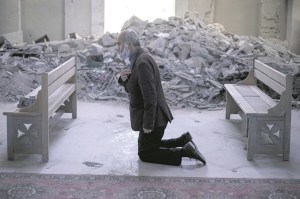Debunking 4 myths against Jesus' resurrection

Every year at this time we see magazine covers questioning the resurrection of Jesus and whether it actually occurred. Here, I want to investigate the biblical and historical claims about the resurrection and debunk four myths against it.
The biblical accounts of the resurrection are historical and worth investigating because if what the Gospel writers said is false, then as Paul said in 1 Corinthians 15:17, our faith is futile, we are still in our sins, and the resurrection is the biggest hoax mankind has ever known. But if they are right, and Jesus was resurrected from the dead, that’s a game changer for the human race and the most vital piece of historical information that every human being must know for the sake of their own souls.
Besides the four Gospel writers who were eyewitnesses, other historians wrote about the crucifixion of Jesus. Josephus, Tacitus and Pliny the Younger were three of them.
The Swoon Theory
Roman crucifixion was common in the first century. Romans used this method of execution to punish members of the lower class, slaves, soldiers, the violently rebellious, and those accused of treason.[1] We know for a fact that Jesus was crucified. But adherents of the Swoon Theory argue that Jesus never really died in the first place. He only swooned, then fainted from exhaustion. After several hours, in the cool of the tomb, He recovered His strength, rolled the stone away, dealt with the guards, and then appeared to His disciples.
This theory not only completely ignores the details of His death that we know, but is so far-fetched that it would take more faith to believe this theory than the truth of the resurrection.
The historical record shows that Jesus' legs weren’t broken to speed up his death, as were the legs of the other two men who were crucified. His legs weren’t broken because the guards saw that Jesus was already dead. In fact, they pierced his side to make sure he was dead, watching blood and water come out — a sure sign of death.
In addition, Pilate the Roman Prefect acknowledged that Jesus was dead, and released the body to Joseph of Arimathea for burial.
Last, after Jesus rose again, and appeared to His disciples, his body was transformed and was anything but weak. He was able to enter locked rooms. He was able to walk the seven miles on the Emmaus Road to appear to eyewitnesses. After what Jesus had just been through, neither of those things could have happened had His body not been transformed after the resurrection. The Swoon Theory falls flat.
The body was stolen
When the Jewish leaders were told by the tomb guards that Jesus’ body was missing, they gave the soldiers a large sum of money, telling them, “You are to say His disciples came during the night and stole Him away while we were asleep.” Here’s the problem with this theory — it doesn’t explain how the seal on the tomb was broken. The day after Jesus died, Pilate ordered that a very large, and heavy stone be rolled in front of the tomb, and a seal put on it to prevent the disciples from stealing Jesus’ body. He even placed guards there to protect the tomb. These two factors, the seal and the stone, make the religious leader’s claim impossible. First, if the guards fell asleep, and let someone steal a body, that was an offense punishable by death. These were highly disciplined and skilled Roman soldiers. The threat of death was enough to keep them on their toes.
The spiritual resurrection theory
There are two Spiritual Resurrection Theories. One claims that Christ’s body decayed in the tomb and His resurrection was only spiritual (a ghost). The other theory asserts that God destroyed Christ’s body in the tomb and that His resurrection was also only spiritual, and not physical.[2] Both of these theories maintain that witnesses didn’t see Jesus’ risen, physical body, only His ghost.
There are some sizable problems with this theory. First, by definition, a resurrection must include a physical body or it’s not a resurrection. It’s a resuscitation. A resurrected body is enhanced. A resuscitated body is the same body that has been brought back to life that will die again, such as the body of Lazarus.
Second, Jesus completely debunked this theory when He said in Luke 24:39, “See My hands and My feet, that it is I myself. Touch Me and see, for a spirit does not have flesh and bones as you see that I have.” Then He ate with them! A spirit doesn’t eat. In Matthew 28:9, His followers took hold of His feet and worshiped Him. One cannot grab the feet of a spirit!
The hallucination theory
Skeptics such as German Theologian Gerd Ludemann argue that Paul and the other apostles had an active sensual perception of Jesus’ resurrection and that they communicated this vision to the other followers, by way of a chain reaction, which resulted in subjective visions among the masses. Over 500 people had this vision, amounting to mass ecstasy.[3]
In a nutshell, Ludemann makes the assumption that everyone who saw the risen Christ imagined it. There are two problems with that claim; He has no basis for proof, and there is too much biblical and psychological evidence to refute his argument.
First, as Gary Habermas argues, hallucinations are subjective experiences, which cannot be shared. Clinical psychologist Gary Collins tells us that hallucinations are individual occurrences. By their very nature, only one person can see a given hallucination at a time. Neither is it possible that one could induce a hallucination in someone else. Since hallucinations are individual experiences, it is obvious that others cannot witness them.[4] Collins isn’t the only psychologist who maintains this opinion. Most psychologists dispute the possibility of group hallucinations.
Second, Claremont McKenna College professor of Philosophy Dr. Steven T. Davis, notes that typical causal factors were not present. There were no drugs, no hysteria, deprivation of food, water, or sleep that would have caused the disciples to hallucinate.[5] In other words, the disciples were not delusional, and the historical record does not reveal that these traits existed in the witnesses.
The evidence for the resurrection of Christ is overwhelming. None of these resurrection theories can explain every detail that is historically known about the resurrection. Since the aforementioned theories do not adequately explain all parts of the biblical testimony, and are constructed from pre-conceived notions, which do not let the historical evidence speak for itself, the traditional hypothesis of Jesus’ resurrection is still the most plausible theory.
[1] Gary R. Habermas and Michael R. Licona, The Case for the Resurrection of Jesus, (Grand Rapids, MI., Kregel, Inc. 2004) 48
[2] Josh and Sean McDowell, Evidence for the Resurrection: What it Means for Your Relationship With God, (Wheaton, Ill., Tyndale House, 1996) 204
[3] Gerd Ludemann, The Resurrection of Jesus: History, Experience, Theology (Minneapolis: Fortress, 1994), 50.
[4] Gary Habermas, Did Jesus Rise From the Dead? (San Francisco, Harper and Row, 1987), 50.
[5] Steven T. Davis, Risen Indeed (Grand Rapids, MI: Eerdmans, 1993), 184.
Claudia is a Christian apologist, national speaker, and blogger with a Master of Arts degree in Christian Apologetics from Biola University. She is on the speaking team for the Talbot Seminary Biola On-The-Road Apologetics conferences, teaches Apologetics at her church, and leads the ladies Bible study. Claudia has been a repeat guest on the KKLA radio show in Los Angeles, Real Life With Gina Pastore and David James. Her blog posts have been published multiple times in The Poached Egg online apologetics magazine, and she is a contributing writer for Women In Apologetics. She blogs at Straight Talk With Claudia K. After raising two now adult sons, her focus now is to make an impact in the world for Christ.




























